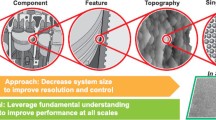Abstract
Study of surface properties is of significance in tribology since interaction between objects takes place at surface level and also surface properties are different than the bulk of the material. This chapter discusses about different surface probe techniques which are used to characterize the surface at nanoscale. Depending upon the interaction of the probe (electron/mechanical) with the sample, different techniques are developed. In case electron probe, scanning electron microscope and transmission electron microscope are used to study surface as well as subsurface information. In case of mechanical probes, atomic force microscope and nanoindentation techniques are widely used in nanoscale tribology. Each of the above techniques is discussed in this chapter with the working principle to application along with the limitations. Finally, recent developments in real-time tribological studies or in situ techniques are discussed.
Access this chapter
Tax calculation will be finalised at checkout
Purchases are for personal use only
Similar content being viewed by others
References
Beilby G (1921) Aggregation and flow of solids. Macmillan, London
Bowden F, Hughes TP (1937) Physical properties of surfaces. IV. Polishing, surface flow and the formation of the Beilby layer. Proc Roy Soc Lond A 160:575–587
Bhushan B (2003) Adhesion and stiction: mechanisms, measurement techniques, and methods for reduction. J Vac Sci Technol B 21:2262
Goldstein J et al (2003) Scanning electron microscopy and x-ray microanalysis. Springer Science + business media, New York, NY
Donald AM (2003) The use of environmental scanning electron microscopy for imaging wet and insulating materials. Nat Mater 2:511–516
Crockett R, Roos S, Rossbach P, Dora C, Born W, Troxler H (2005) Imaging of the surface of human and bovine articular cartilage with ESEM and AFM. Tribol Lett 19(4):311–317
Williams DB, Carter CB (2009) Transmission electron microscopy. A textbook for materials science. Springer Science + business media, New York, NY
Bobji MS (1999) Studies in depth sensing indentation, Ph.D. Thesis, Indian Institute of Science, Bangalore
Tabor D (1951) Hardness of metals. Oxford University Press, New York, NY
Oliver WC, Pharr GM (1992) An improved technique for determining hardness and elastic modulus using load and displacement sensing indentation experiments. J Mater Res 7(06):1564–1583
Fischer-Cripps AC (2004) Nanoindentation. Springer, New York, NY
Li X, Bhushan B (2002) A review nanoindentation continuous stiffness measurement technique and its applications. Mater Charact 48(1):11–36
Bhushan B (1999) Handbook of micro/nanotribology, 2nd edn, CRC Press LLC, Boca Raton, FL
Singer L, Pollock HM (1992) Fundamentals of friction: macroscopic and microscopic processes. Kulwer Academic Publishers, Netherlands
Lim SC, Brunton JH (1985) A dynamic wear rig for the scanning electron microscope. Wear 101:81–91
Rabea R, Breguetb JM, Schwallera P, Staussa S, Hauga FJ, Patscheidera J, Michlera J (2004) Observation of fracture and plastic deformation during indentation and scratching inside the scanning electron microscope. Thin Solid Films 469–470:206–213
Suh NP (1986) Tribophysics. Prentice-Hall, Inc, Englewood Cliffs, NJ
Rigney DA (1981) Fundamentals of friction and wear of materials. American Society for metals, Metals Park, OH
Gane N (1970) The direct measurement of strength of metals on a sub-micrometer scale. Proc Roy Soc Lond A 317:367–391
Wall MA, Dahmen U (1998) An in situ nanoindentation specimen holder for a high voltage transmission electron microscope. Microsc Res Tech 42:248–254
Wall MA, Stach EA, Freeman T, Minor AM, Owen DK, Cumings J, Chraska T, Hull R, Morris JW Jr, Zettl A, Dahmen U (2001) Development of a nanoindenter for in situ transmission electron microscopy. Microsc Microanal 7:507–517
Minor AM, Morris JW Jr, Stach EA (2001) Quantitative in situ nanoindentation in an electron microscope. Appl Phys Lett 79(11):1625–1627
Kizuka T (1998) Atomic visualization of deformation in gold. Phys Rev B 57:158–163
Erts D, Lohmus A, Lohmus R, Olin H (2001) Instrumentation of STM and AFM combined with transmission electron microscope. Appl Phys A 72(suppl):S71–S74
Bobji MS, Ramanujan CS, Pethica JB, Inkson BJ (2006) A miniaturized TEM nanoindenter for studying material deformation in situ. Meas Sci Technol 17:1–6
Bobji MS, Pethica JB, Inkson BJ (2005) Indentation mechanics of Cu–Be quantified by an in situ transmission electron microscopy mechanical probe. J Mater Res 20(10):2726–2732
Anantheshwara K, Bobji MS (2010) In-situ transmission electron microscope study of single asperity sliding contacts. Tribol Int 43(5–6):1099–1103
Anantheshwara K, Lockwood AJ, Mishra RK, Inkson BJ, Bobji MS (2012) Dynamical evolution of wear particles in nanocontacts. Tribol Lett 45(2):229–235
Lockwood AJ, Anantheshwara K, Bobji MS, Inkson BJ (2011) Friction formed liquid droplets. Nanotechnology 22:105703
Author information
Authors and Affiliations
Corresponding author
Editor information
Editors and Affiliations
Questions
Questions
-
1.
Explain any five ways in which the electron interact with the materials and how each one of these is exploited to characterize the materials
-
2.
What is an atomic force microscope? How is it used to obtain atomic resolution images? Sketch the displacement of the cantilever as a function of the separation distance between the tip atom and the surface, assuming an ideal case of a tip consisting of a single atom.
-
3.
Explain the principle behind the Auger electron spectroscopy.
-
4.
What is a transmission electron microscope? How is it used to characterize the materials?
-
5.
What are the different material properties that can be determined by nanoindentation? Explain how any two properties are measured.
-
6.
Describe the significance of in situ techniques. Explain how these techniques became useful in the study of surface interactions.
Rights and permissions
Copyright information
© 2013 Springer Science+Business Media New York
About this chapter
Cite this chapter
Anantheshwara, K., Bobji, M.S. (2013). Surface Probe Techniques. In: Menezes, P., Nosonovsky, M., Ingole, S., Kailas, S., Lovell, M. (eds) Tribology for Scientists and Engineers. Springer, New York, NY. https://doi.org/10.1007/978-1-4614-1945-7_16
Download citation
DOI: https://doi.org/10.1007/978-1-4614-1945-7_16
Published:
Publisher Name: Springer, New York, NY
Print ISBN: 978-1-4614-1944-0
Online ISBN: 978-1-4614-1945-7
eBook Packages: Chemistry and Materials ScienceChemistry and Material Science (R0)




